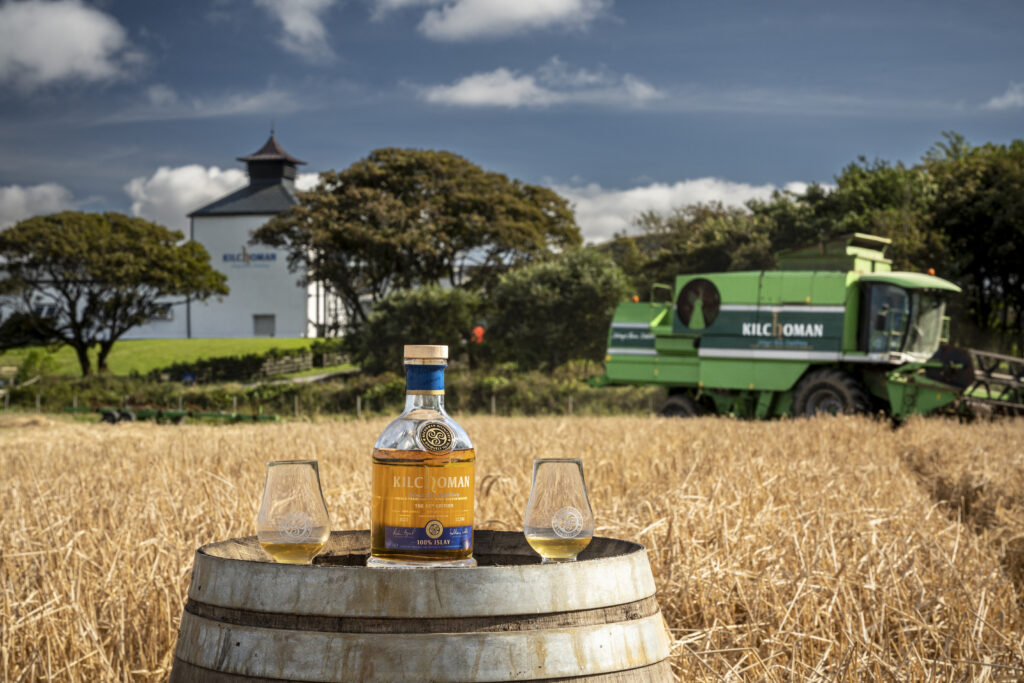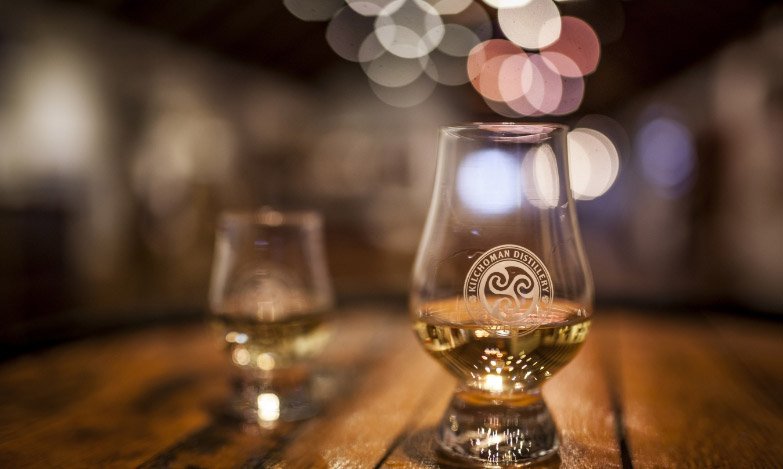The Kilchoman Land Rover is heading back on the road! After European tours in 2014, 15′, and 18′ we’re loading up the Land Rover with Kilchoman goodies and heading across Europe once again. This time we’ll be hitting 13 countries during a six week tour, starting in Luxembourg on April 16th, finishing back on Islay for our Fèis Ìle.

As well as our range of award winning whiskies and an exclusive tour bottling, we’ll also be bringing some of our famous new make spirit. Robin Bignal and his production team will be dialling in via live feed from the distillery to explain how we make our unique spirit and where those aromas and flavours come from.

The European Tour limited edition release of 3,325 bottles is exclusively available at the tour stops. Matured in bourbon and port casks and bottled at natural cask strength (58.5%), this release is a punchy mix of red berries, mixed spices, fresh vanilla sweetness and integrated maritime peat smoke. You don’t want to miss out on this one!
See the full list of tour stops below, a blend of informal afternoon events and larger evening tastings. Come along and say hi to the team, hear some stories of life at Kilchoman, taste some great whisky and have some fun!
Belgium / Luxembourg
16TH APRIL : Shopping Centre Massen, Wemperhardt, LU
17TH APRIL : De Schelf Spirits, Hamme, BE
18THAPRIL : Huis Aerts, Bree, BE
19THAPRIL: Drink Factory, Mons, BE
20THAPRIL: TasTToe, Boortmeerbeek, BE
Netherlands
21ST APRIL : Van der Boog, The Hague
Vonk Zaandam, Amsterdam
22ND APRIL : Woudenberg Whisky Show, Utrecht/Arnhem
23RD APRIL : Berendsen Dranken, Enschede
Germany
26TH APRIL : Whisky For Life, Frankfurt
Whisky Spirits, Frankfurt
27TH APRIL : Hilgering, Dortmund
28TH APRIL : Men’s Needs, Hamburg
Weinquelle Lühmann, Hamburg
29TH APRIL : KaDeWe, Berlin
Whisky & Cigars, Berlin
1ST MAY : Tara Spirits, Munich
Austria
2ND MAY : Potstill, Vienna
3RD MAY : Dr. Bottle, Graz
Slovakia
4TH MAY : Svet Nápojov, Bratislava
The Izzi Pub, Bratislava
Hungary
5TH MAY : GoodSpirits Bar, Budapest
Croatia
6TH MAY : Fine Stvari, Zagreb
Esplanade Hotel, Zagreb
Slovenia
9TH MAY : Lord Byron Pub, Koper
Italy
10TH MAY : Ferrowine, Castelfranco
Boss Hogg Whisky County, Treviso
11TH MAY : Whisky Antique, Formigine
Atlas Whisky Bar, Bologna
12TH MAY : Baobab Café, Milano
Julep Cocktail Bar, Milano
13TH MAY : Whisky Club Italia, La Limonaia di Merone
XXL Café Chivasso, Torino
Switzerland
16TH MAY : Globus, Zürich
The Whisky Store, Rapperswil-Jona
17TH MAY : Häberli, Dagmersellen
Friends of Isles & Islay, Lucerne
France
18TH MAY : La Bouchonnerie, Annecy
La Java des Flacons, Annecy
19TH MAY : Bon Plan du Vin, Beaune
Whiskies & Spirit, Beaune
20TH MAY : Au Secret du Vins, Lille
UK
24TH MAY : Milroys of Soho, London
The Whisky Exchange, London (Covent Garden)
25TH MAY : Aston’s of Manchester, Manchester
House of Malt, Carlisle
26TH MAY : RMW, Edinburgh
Uesquebae, Edinburgh
27TH MAY : Good Spirits, Glasgow
Robbie’s Drams, Ayr
28TH MAY : Green Welly Stop, Tyndrum
The George Hotel, Inverary
For more information about events and how to purchase tickets please contact the venues directly
For general enquiries please email info@kilchomandistillery.com
Anthony Wills, Kilchoman Founder & Master Distiller, has always placed great importance on sourcing casks of the highest quality. This is precisely what he obtains from José y Miguel Martín, whose sherry casks are always of exceptional quality.
In February 2023, Kathy and Anthony went on a trip to Spain to visit Miguel Martín, our sherry cask supplier since the distillery was founded in 2005. Over the years, a great working relationship has flourished, and Miguel Martín consistently provides sherry casks of outstanding quality. During the visit Kathy and Anthony had the opportunity to spend some time on-site with Miguel and meet some of the individuals involved in the family business, from the team crafting the casks in the cooperage to the people producing and maturing the sherry wines in the bodegas.
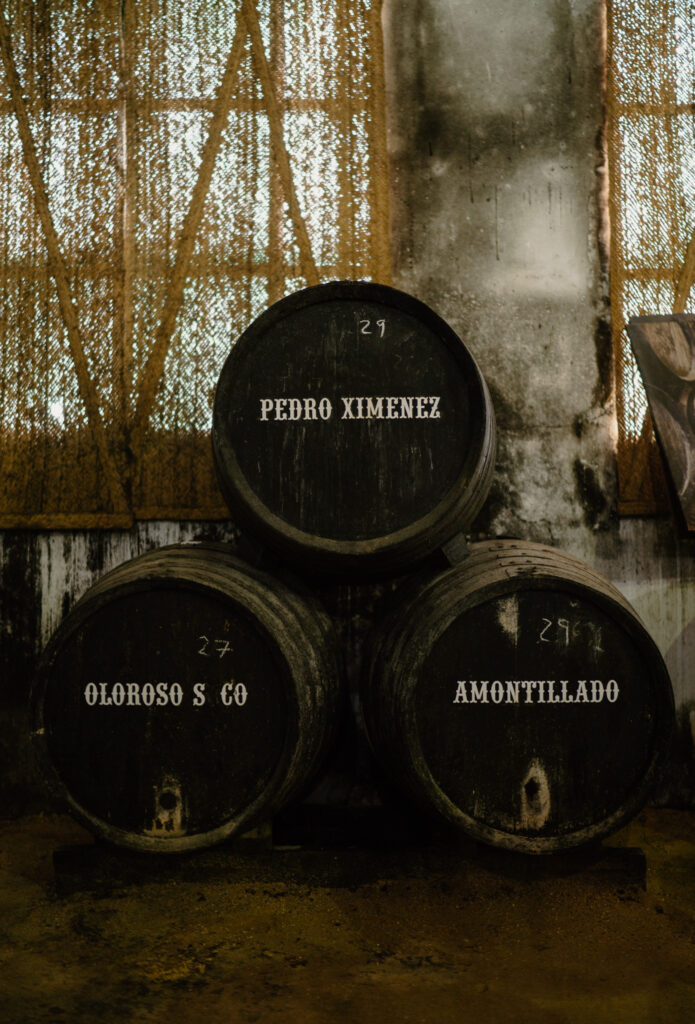
The visit provided a glimpse of the passion and enthusiasm that the José y Miguel Martín team have for creating the highest quality casks. From sourcing the best American and European oak to the meticulous process of constructing the highest quality casks on-site, to exploring and learning more about the production of different sherry wines, the trip was very successful and enjoyable for Kathy & Anthony and only deepened their appreciation for what Miguel and his team do. And of course, tasting the different sherries along the way was definitely a highlight. Anthony now has his eye on some other sherry cask types to experiment with at Kilchoman!

Family Business
Anthony and Kathy Wills founded Kilchoman in 2005. As the business grew, their three sons, George, James and Peter, came on board. Kilchoman has remained an independently owned and family run business, which is fairly unique in the whisky industry.
Anthony is delighted to be able to source his sherry casks from José y Miguel Martín, which is also a family run business. It was a privilege and a pleasure to spend time with Miguel, who is the second generation in his family business, as well as other family members including his nephews.
“I always enjoy working with family run businesses. The passion, commitment and work ethic is something you don’t always see at large multinational companies. Miguel has a vision for his business which is similar to mine. Always produce quality products and be one step ahead of the competition”,
Anthony Wills, Kilchoman Founder

The Cooperage
At Kilchoman we buy our casks directly from source whenever possible to ensure the casks are of a consistently high quality. Being able to take a step further back and learn more about the oak being sourced and the process of how the casks are made was fascinating. Seeing the coopers at work and learning more about the traditional craft, leaves you with a deep appreciation of their expertise and again highlighted that the sherry casks we obtain are crafted with exceptional quality at the forefront.
Traceability is something we often talk about, particularly with our 100% Islay releases which are produced from barley grown on our own farm. It is also something that is being further developed by Jose y Miguel Martín, with the aim of developing a system to enable them to trace the oak back to the location of the forest, identify which cooper crafted each individual cask and the maturation details of the sherry in each cask.
Oloroso Sherry Casks – Loch Gorm
Our Loch Gorm release is exclusively matured in oloroso sherry casks from José y Miguel Martín. These American oak butts are shipped fully intact from their bodegas in Jerez all the way to Islay. By not breaking the casks down for transportation, it ensures that casks arrive at the distillery in the best possible condition ready for us to fill.
The 2024 edition of Loch Gorm was distilled in 2014 and matured in oloroso sherry butts. We use butts for Loch Gorm with the aim of maturing over a longer period of time to give us the balance and depth between the distillery character with the sherry flavours from the casks. This year’s release has an abundance of rich spices and toffee notes – click here for more info.
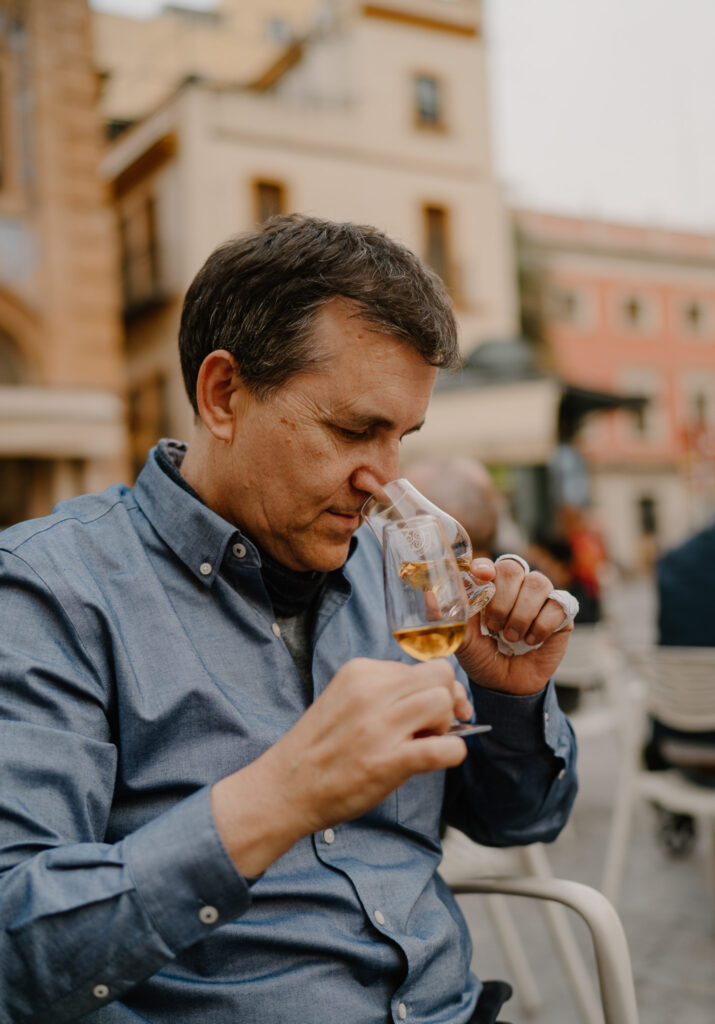
The eagerly awaited annual release of Loch Gorm has arrived! The vatting has been completed and bottles will be hitting shelves around the world any day now.
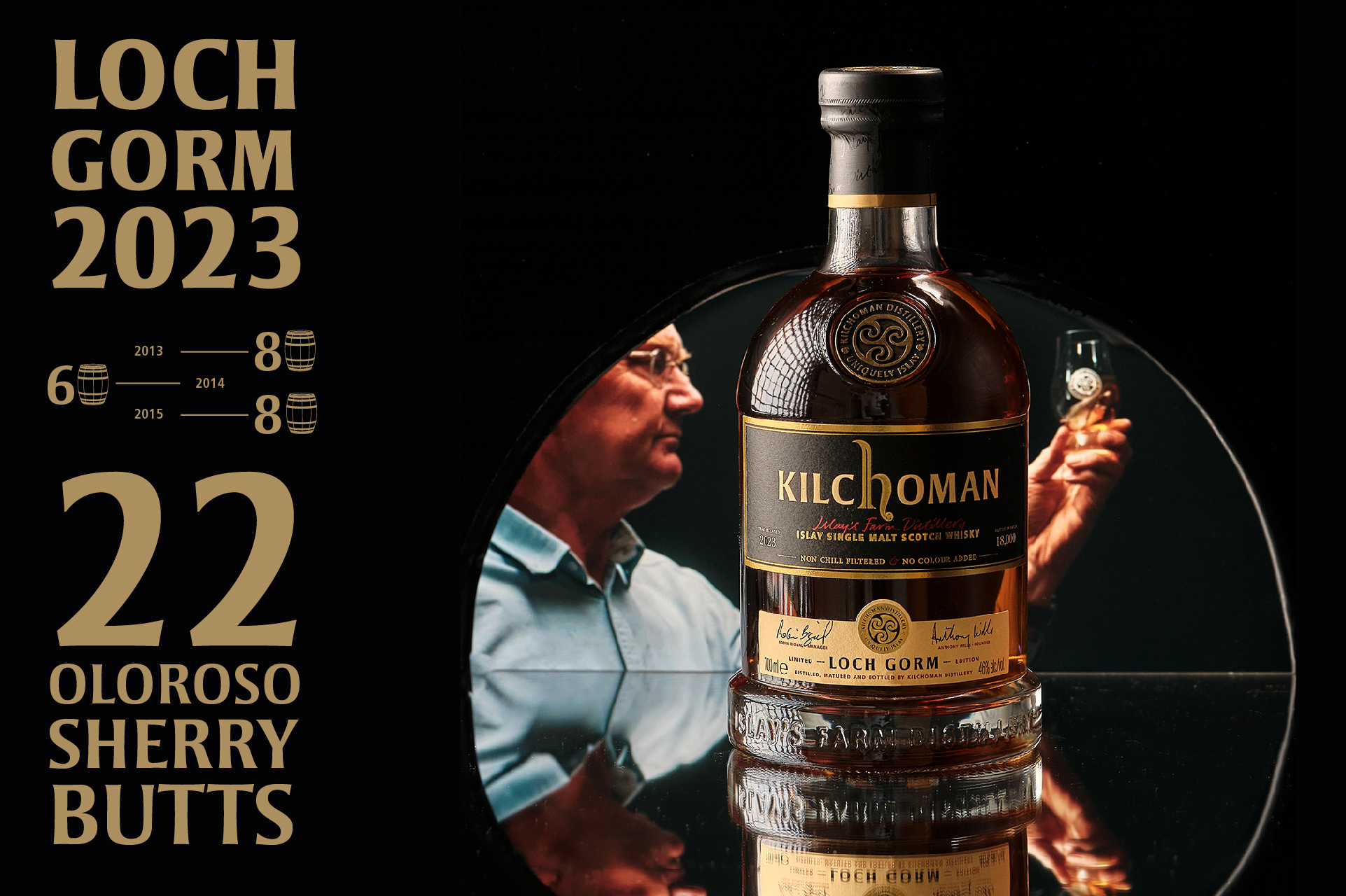
Named after the famously dark, peaty loch overlooked by the distillery, our annual Loch Gorm limited edition is our only regular expression matured entirely in oloroso sherry casks.
For the 2023 Edition Anthony and Robin selected a total of 22 casks, 8 distilled in 2013, 6 distilled in 2014, and 8 distilled in 2015. This latest edition of Loch Gorm will be available from Kilchoman stockists around the world from this week (a little longer for those living further away from Scotland). Please contact us if you have any questions about where to find a bottle.
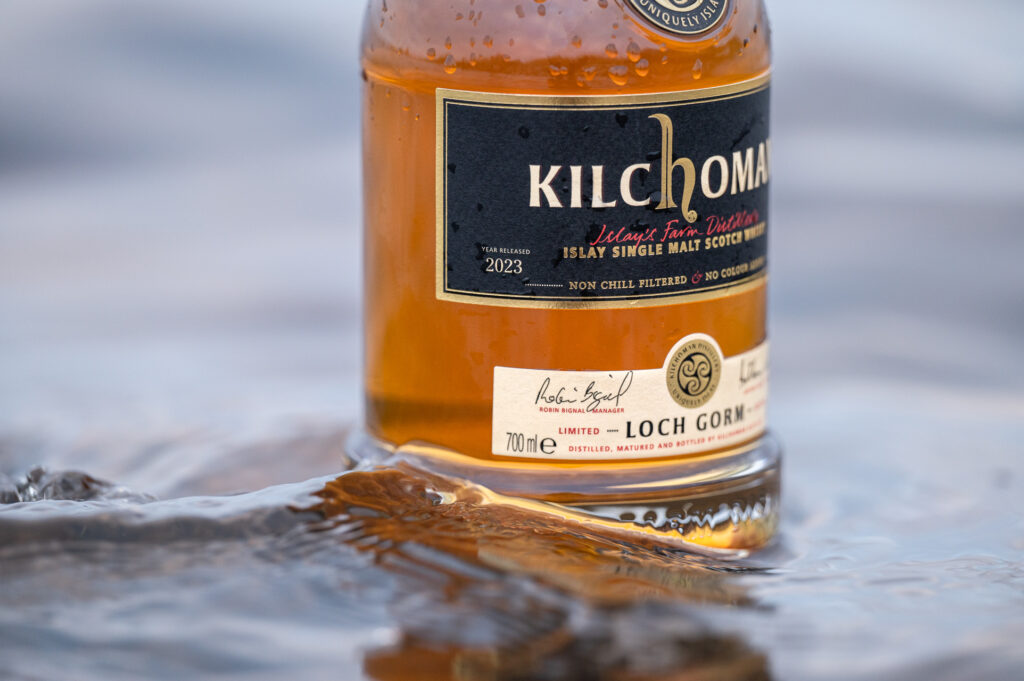
Each cask was chosen for its unique flavour profile which, when combined together with the other 21 casks, create a beautiful balance of rich fruity character with layers of classic Kilchoman peat smoke and citrus sweetness.
“Rather than dominating, Loch Gorm’s oloroso maturation works in harmony with the natural character of Kilchoman. The 2023 release has a fantastic spectrum of flavour, from rich spices and macerated peaches to fresh citrus, ginger, orange zest and waves of salty peat smoke,”
Anthony Wills, Kilchoman Founder.
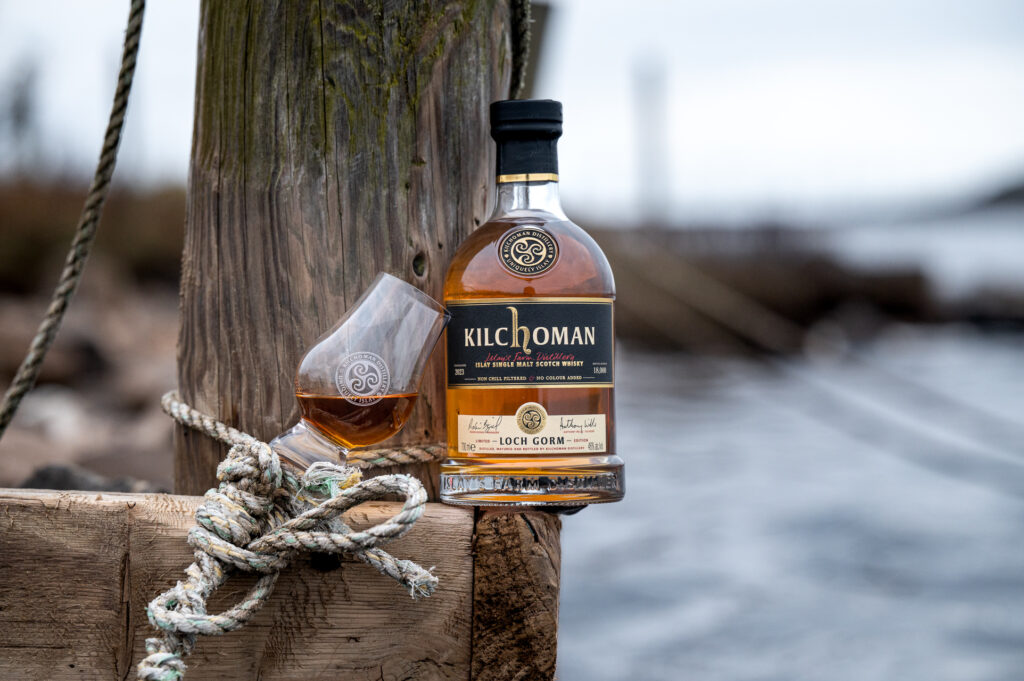
Loch Gorm 2023 will be available from your regular Kilchoman stockists around the world from this week.
For more information email info@kilchomandistillery.com
Click here to become a Kilchoman Club Member and be one of the first to hear about all our future releases and other news from the distillery.
Our Visitor Centre & Café is now open six days per week from 9:45am to 5pm (closed on Saturdays).

Tours & Tastings – Bookings made online via our website
Our ‘Classic tours’ take place at 10am & 1.30pm. This is a one-hour guided tour around all our production areas, showing you the steps that go into making our single farm single malt scotch Whisky. On the way around, you get to sample two of our most popular whiskies. Classic tours are £10 per person and under 18s are welcome. Drivers’ drams are also available.
Our Limited Edition Tasting & Tour runs at 11am and lasts 2 hours. Accompanied by one of our guides, you will see first-hand all the processes that go into how we make our whisky. Enjoy a dram of our 100% Islay on the malt floor as we talk you through our barley-to-bottle philosophy. Followed by a tutored tasting of our limited-edition whiskies. The limited-edition tour and tasting is £40 per person – over 18s only. Drivers’ drams are available.
NEW EXPERIENCE! Our ‘Roving Tasting Tour’ promises to be a treat for all your senses. Available at 2.30pm, enjoy a dram in each area of the Distillery, including our traditional malting floor, stillhouse and one of our dunnage style warehouses before heading back to the visitor centre to taste our latest shop exclusive single cask. The roving tasting tour is £25 per person – over 18’s only. Driver drams available.

Whisky Bar
Our tasting bar is open from 10am to 4.45pm. You can sample all of our current range of whiskies as well as some of our archive stock from the past 16 years. Our knowledgeable staff will be happy to welcome you to the visitor centre and answer any of your Kilchoman questions, while guiding you through your tasting. No booking required.
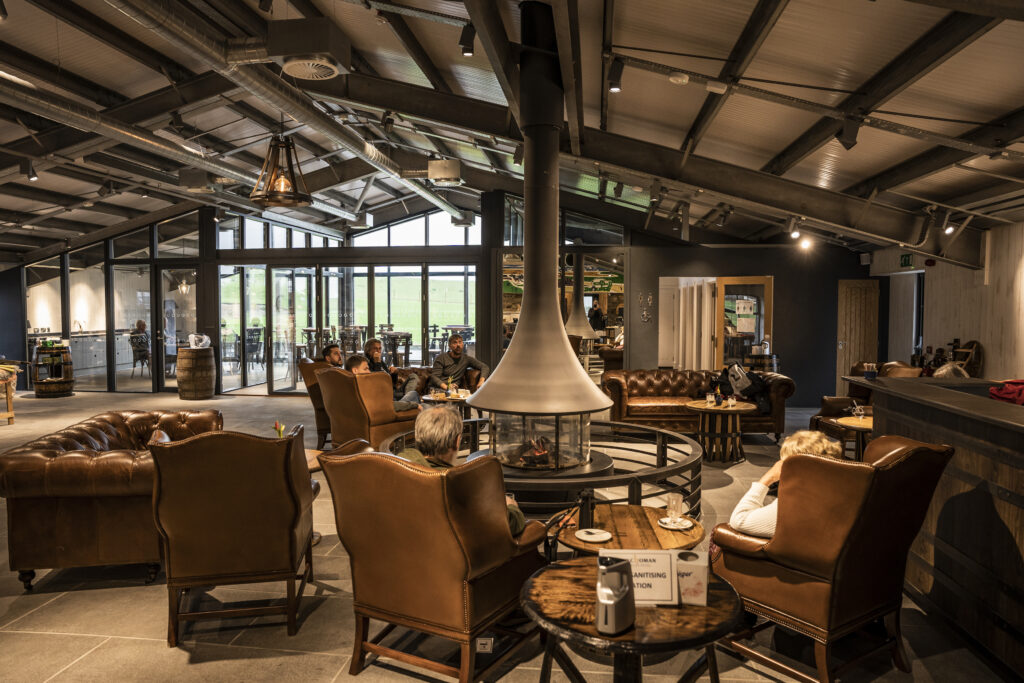
Café
Our on-site café is open from 10am to 4.30pm. Freshly prepared light lunches are served from 12noon to 3.30pm. A set menu is available for groups of 10 and above. For more details or to reserve a table, please contact: tours@kilchomandistillery.com or call us on 01496 850 011. Booking is advised.
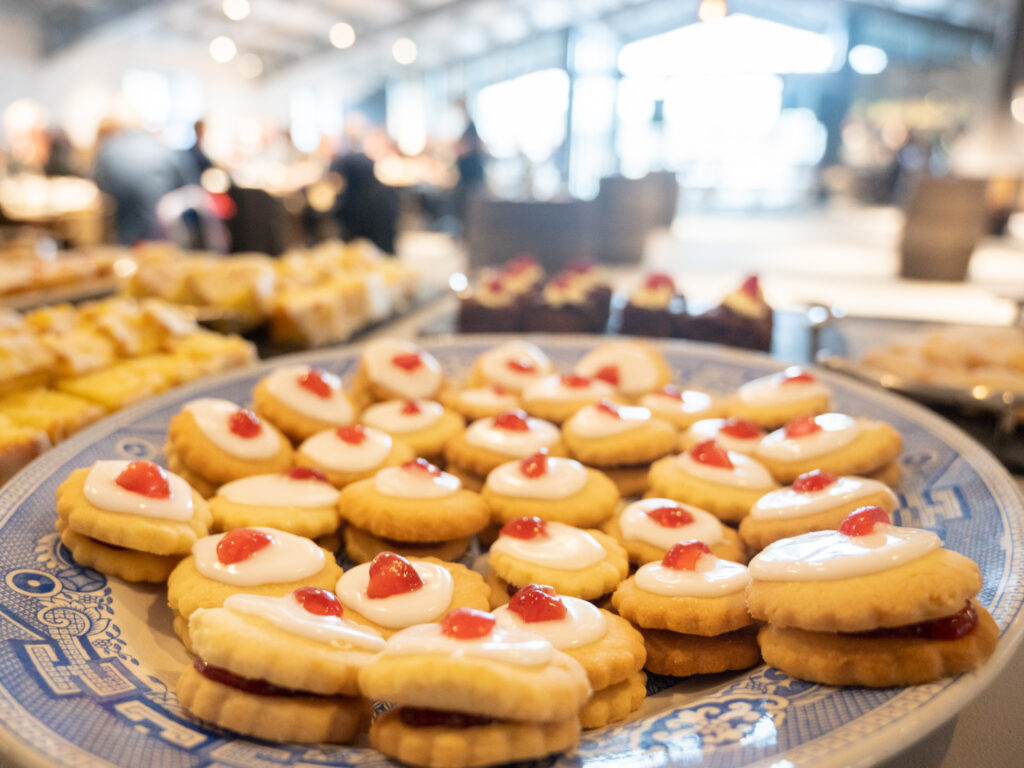
Scotland, and more precisely, Islay, has long been associated with producing heavily-peated styles of Single Malt whisky, but when does that renowned flavour and influence of peat smoke become part of the whisky making process and when is the PPM content measured?
If you are, or have been, fortunate enough to visit Kilchoman Distillery on Islay, you will see that to produce our 100% Islay releases, we’re able to not only grow our own barley on site at the farm surrounding the distillery but we’re unique in that we also malt our barley on site at the distillery using traditional floor maltings; this is a key part in being Islay’s Farm Distillery and ensuring that 100% of the process is carried out at the distillery, on Islay.
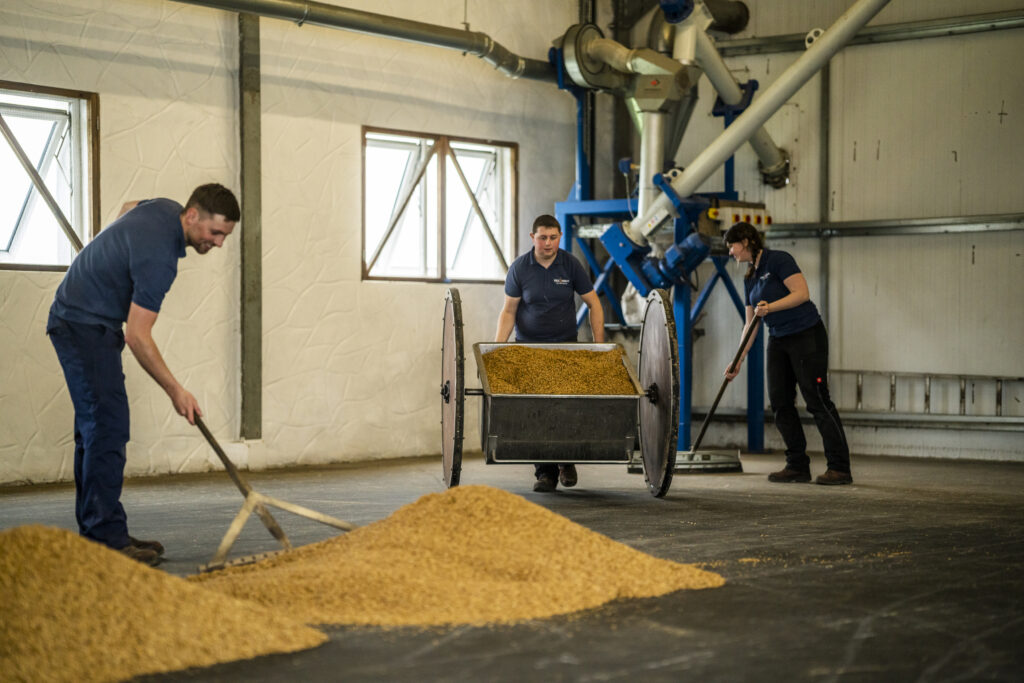
The peated malt used to create our iconic whiskies – whether it be using our traditional floor maltings at the distillery or barley that we purchase from the commercial maltings – the concept is the same; we want to steep, germinate, and kiln the grains of barley in order for them to record a parts per million (PPM) content. You can read more about our malt floor and what goes on, here.
Often, the assumption is that the PPM is measured in the final spirit however as an industry standard, it is measured in the malted barley. This allows for a level of consistency across all producers as multiple factors throughout the production can reduce the PPM total in the bottled spirit. For Kilchoman, this can be tested on site at the distillery however we will send samples of the malted barley to a third party whereby the malt will be analysed for quality and control purposes.
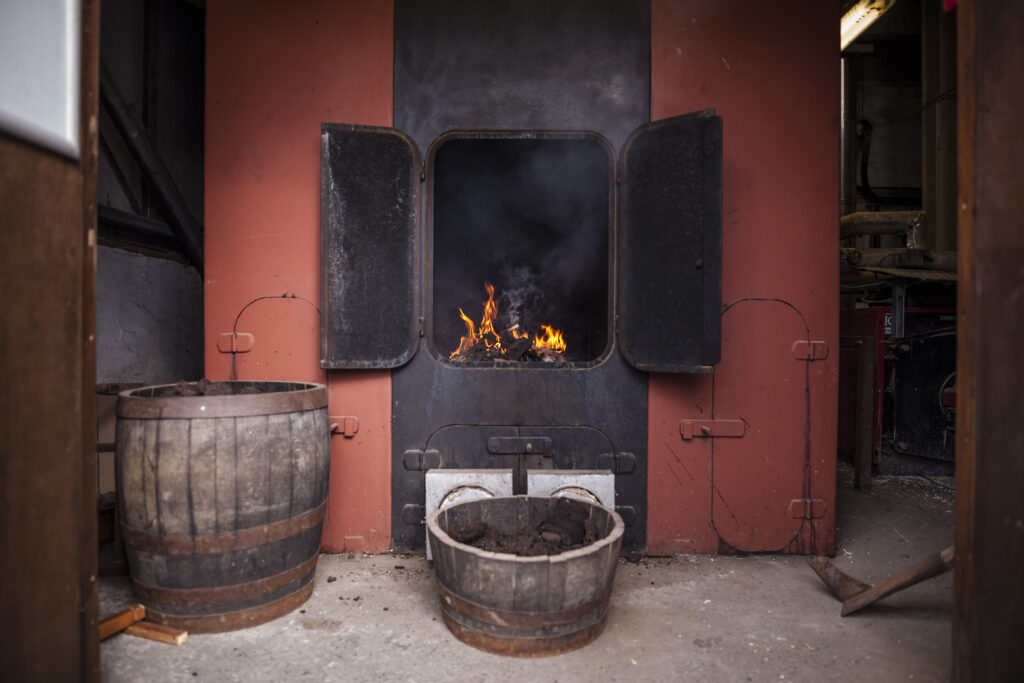
Once steeping and germination on our malt floor have taken place and the distillery team are happy with the quality of grain, kilning is used to stop further germination ensuring we capture the necessary starches required to eventually convert to alcohol during fermentation. It is at this stage that we use peat to influence our malt, producing a distinct ‘smoky’ aroma and taste. Kilning is the point at which our barley is spread out evenly on a mesh floor in the upper part of the kiln, 5 meters above the peat fire. Hand cut Islay peat will be burned on the fire below, allowing the peat smoke to rise and immerse itself into the green malt.
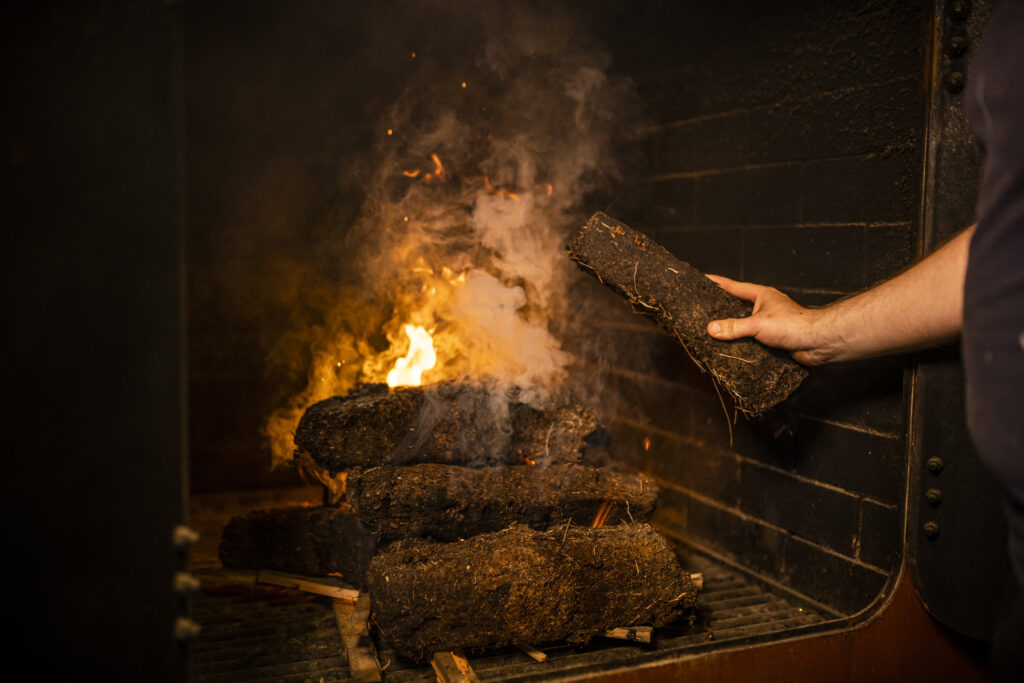
Temperature, airflow, and time are all important factors considered when determining the final PPM as they all have an effect on the overall influence on the malt. A distiller, at this point, can specify the peating level they require.
To aid consistency, at Kilchoman for our 100% Islay Edition, we burn hand cut, Islay peat under controlled conditions for 15 hours. This in turn results in a phenolic level of 20PPM (approx.). Our 50ppm malt is ultimately held under these conditions for a longer period of time, resulting in a higher PPM figure. Increasing the final PPM figure of malt is achieved by lengthening the amount of time the malt spends under the conditions provided by the kilning phase, balancing the temperature, moisture content and the level of smoke being created by the quantity of peat used as well as the rate of burning of the peat. It is important to note that if we were to use warm air (rather than peat) in the kilning process, this would create an unpeated whisky.
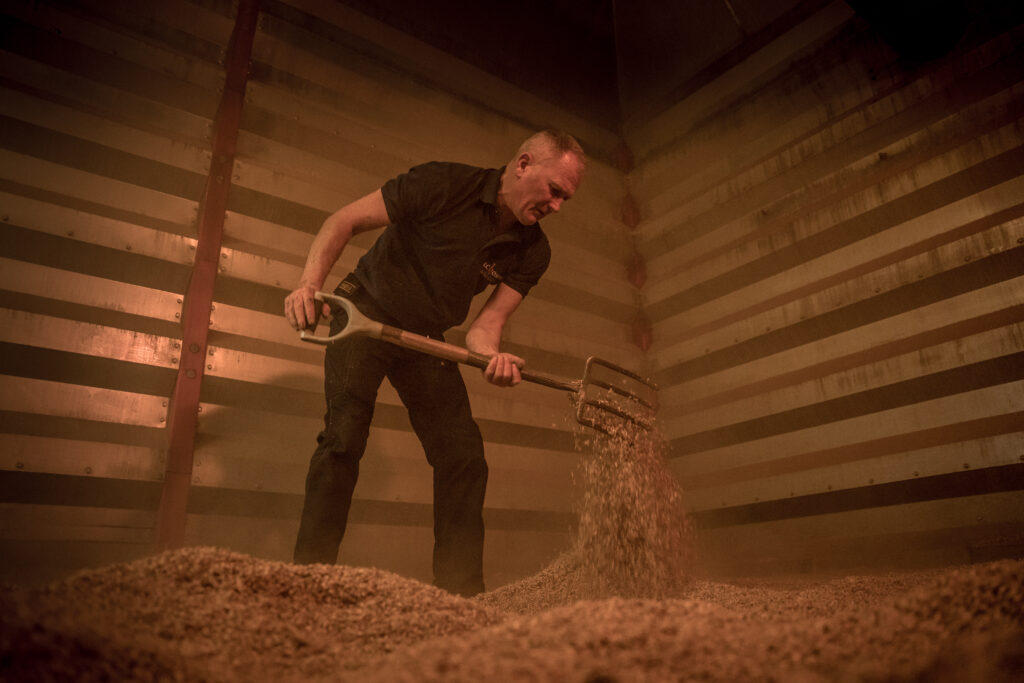
So, does the source of the peat influence the whisky? Each part of the whisky making process has an impact on the final flavour created and the source of the peat is no different. For example, if we were to test highland peat against Islay peat, both would affect the malt profile drastically. At Kilchoman, it’s important that we produce peated malt using peat only from Islay. For our 100% Islay edition, our peat is sourced from a nearby peat bank, managed by Derek Scott, Bottling Hall Manager, while our commercial malt uses peat from the east side of Islay, near Port Ellen resulting in two styles of peated spirit (20PPM and 50PPM). Derek and James take a walk through the malting and peating process here.
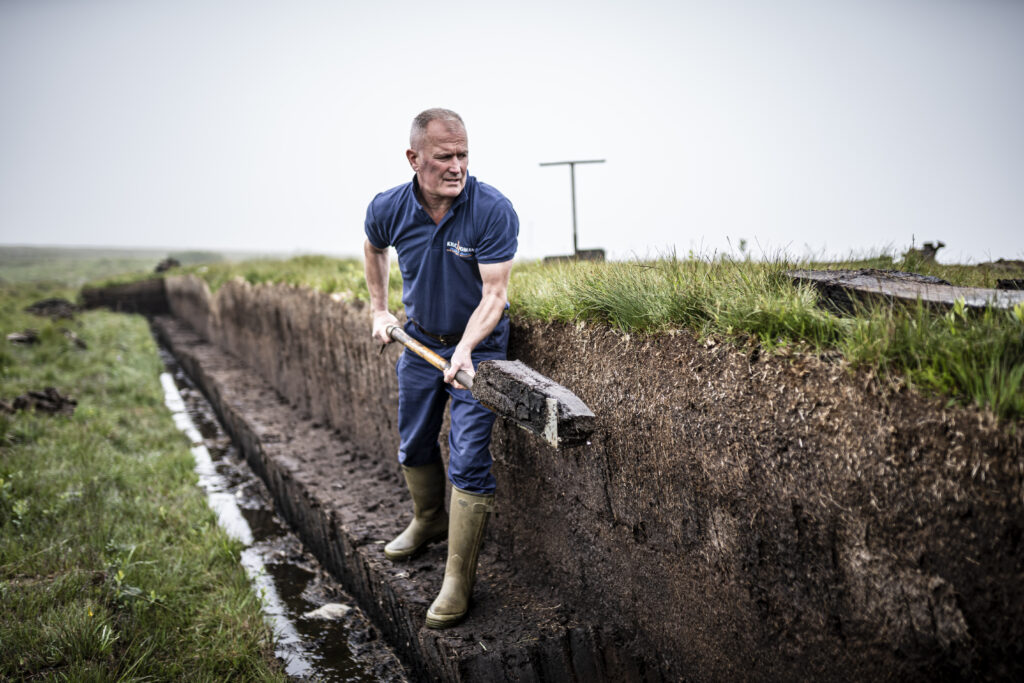
How does all this impact our whisky that’s being tasted around the world? Often during tastings, you will hear the speaker discuss the smoky and peaty characteristics found within the whisky (if it’s a peated malt) but both profiles can be individually defined. It’s easier to note the profile of smoke than it is peat, whether that be through nosing or tasting. Below are a few typical notes to look for:
- Smoky – dry/wet smoke, bonfire smoke, woody and ashy
- Peaty – medicinal (TCP, iodine, tar, seaweed), sulphur and mossy/earthy soil
A mix of the above is possible and when it comes to what you taste, it’s completely individual. Focussing on Kilchoman Single Malt, our aim is to continue producing a classic Islay heavily peated malt but with an elegant balance allowing for notes from the malt, fermentation, distillation, and cask type to play a significant part in the final product.
Click here to stay up to date with all things Kilchoman and be amongst the first to know about new Limited Edition and Exclusive Club Release bottlings!
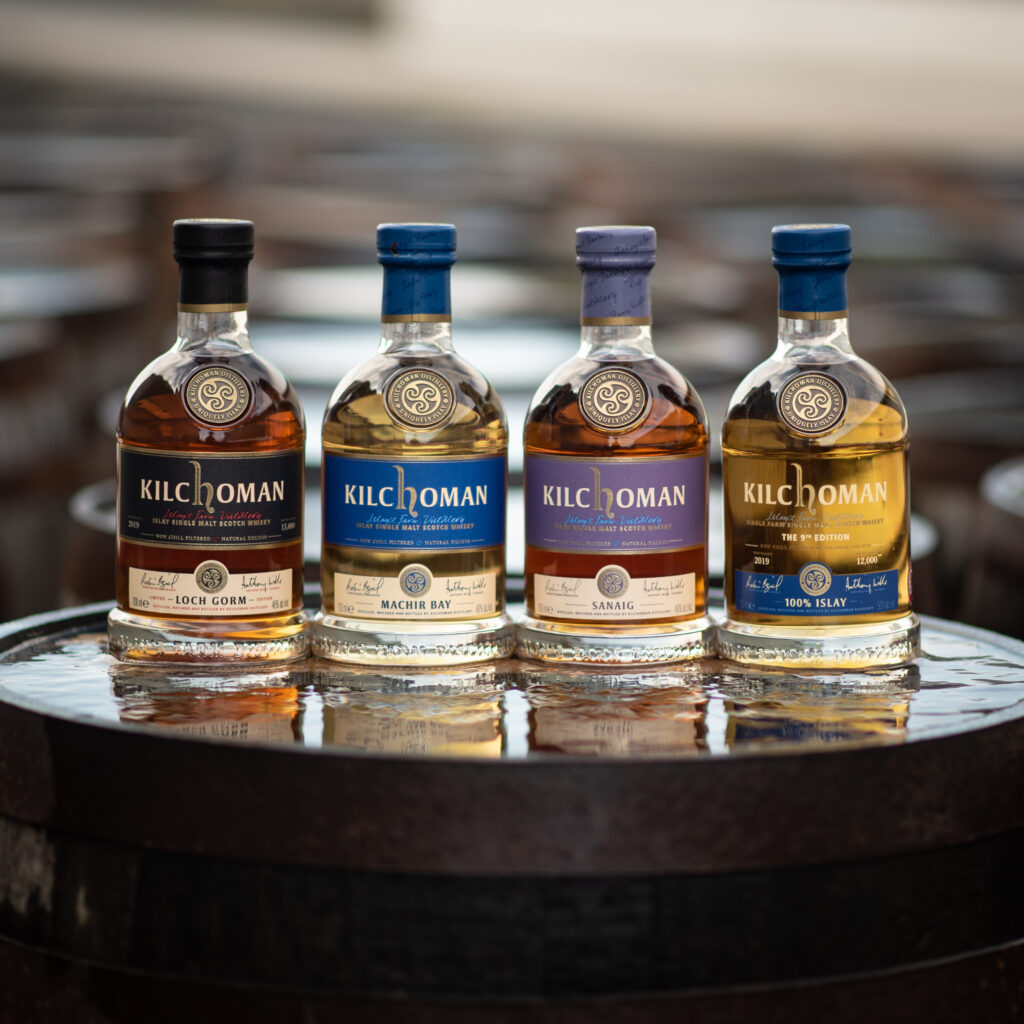
Before we dive into non-age statement (NAS) single malt, let’s cover what an age-statement single malt is.
Once the distilling process is complete, the new make spirit is filled into casks and set aside in warehouses for maturation. Legally, the minimum age of the spirit must reach 3 years old. After this period, it is entirely up to the individual distillery to decide when to decant and bottle. Once bottled, if the distillery chooses to put an age statement on the label, Scotch whisky law declares that the youngest whisky used in the bottling, must be what is stated on the label. For instance, if 12-year-old, 10-year-old, and 5-year-old Single Malt were used in a vatting, legally, it should be marketed as a 5-year-old single malt as this is the youngest age included in the vatting, even if it was a small amount, this must be done.
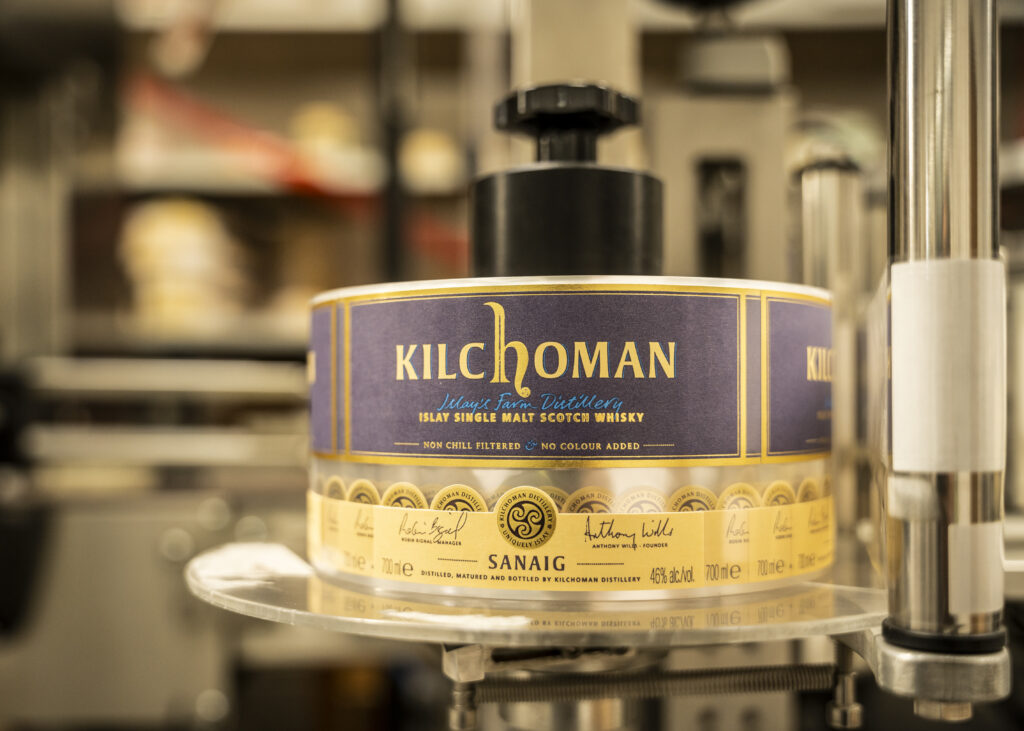
For years, whisky marketing has promoted older whiskies over younger to the global industry. Age statements, typically 10, 12, 15, have been considered a mark of perceived quality as a core whisky in a distillery’s portfolio. Ages 18, 21, 25 and above have been promoted as ‘higher quality’ as historically, the messaging that the older a whisky is, the more value the liquid holds. As the industry progresses, this belief is regularly being challenged. Although there are some excellent older single malts in the world, higher age doesn’t always equal superior flavour.
A non-age statement whisky is when the spirit has been bottled without its maturation age being marked on the label. Often, several ages of spirit are brought together in a vatting pre-bottling and this can be described as a multi-vintage whisky. It’s important to note that vatting/blending doesn’t solely relate to blended scotch but also to Single Malt whisky (if all spirit being vatted together has come from the one distillery).
In the current whisky market, there is a significant rise in NAS whiskies. There are several reasons as to why this change has occurred; one being the global sales growth in single malt subsequently applying pressure on the industry to release more stock. This has resulted in older whisky stocks being used sooner than projected. Many distilleries simply therefore don’t have access to the aged stock they once did. Additionally, NAS has allowed much more flexibility for distillers and blenders to be creative when choosing what to release from their warehouses. For Kilchoman, releasing NAS single malt, gives Anthony additional flexibility in deciding which casks to use in each vatting.
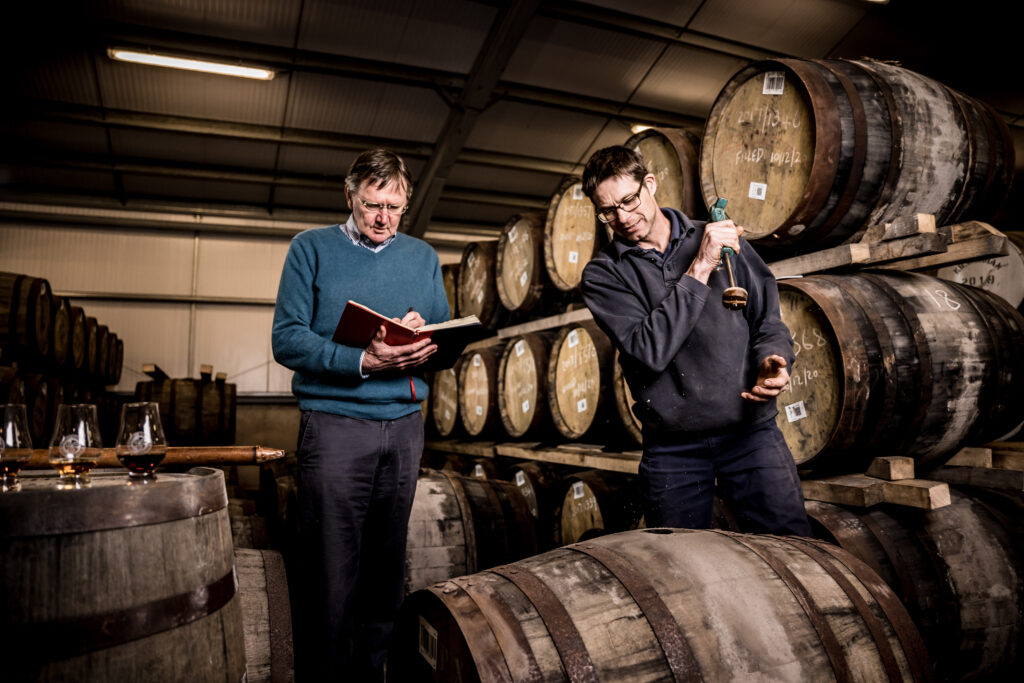
Having an arbitrary age statement on a bottle of our single malt was never the intention. Although as a distillery it is incredible to reach these milestones, Anthony’s vision for Kilchoman was to produce a single malt that focused purely on flavour and a style that hadn’t been showcased in the Islay category in the past; young, fruity, and spirit-forward. All while being balanced, demonstrating an elegant expression of a heavily peated Islay Single Malt. All of these qualities can be achieved – arguably better – when presented as a NAS, without an age statement deciding when the time is correct to bottle. Our core releases, Machir Bay and Sanaig proudly represent their NAS status. These two single malts demonstrate a flavour-first mentality, and not just releasing a younger whisky to accelerate the process.
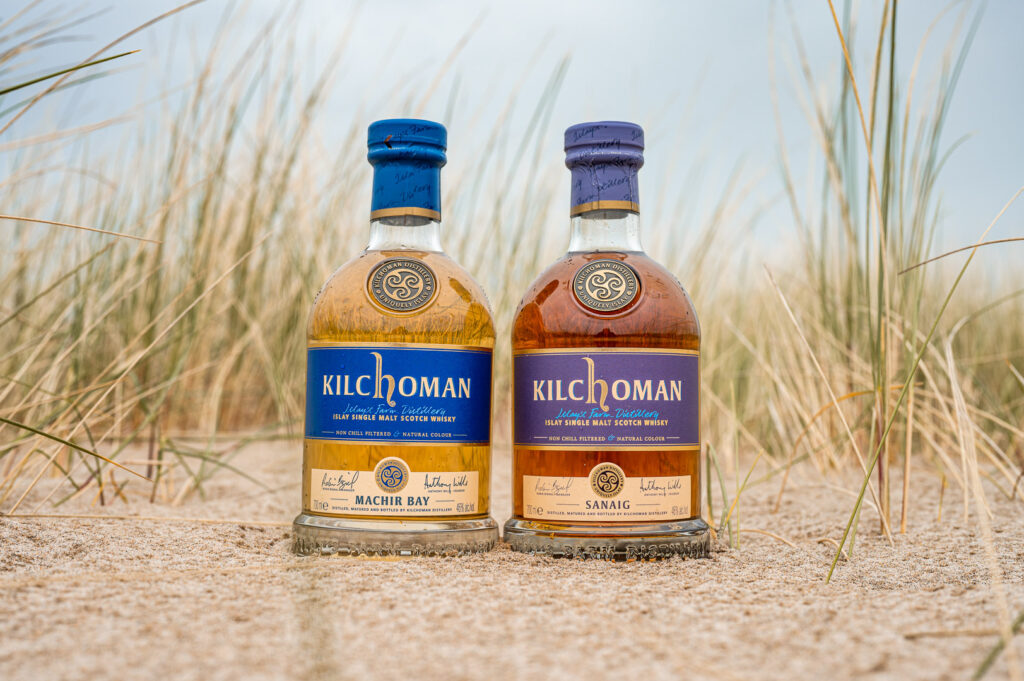
When producing an age-statement whisky, the main aim is to achieve a consistent flavour profile with each vatting. Our goal is to a maintain a certain style for Machir Bay and Sanaig but this is not decided simply by the age of casks, welcoming subtle differences between each vatting. Using the NAS title means that we can use a variety of ages. For example, Machir Bay typically sits between 3 – 8 years old. For those of you who have tasted some of our earlier batches, you will have noticed a natural evolution of flavour within Machir Bay and Sanaig as the age profile has changed over time. Machir Bay remains a 90% Bourbon, 10% Oloroso Sherry maturation split while Sanaig represents a 70% Bourbon, 30% Oloroso Sherry ratio.
It’s important to note that as the spirit matures it naturally will take on more influence from the oak. As mentioned earlier, Kilchoman was designed to reach its peak maturation at an earlier age. When experimenting with cask types, as the maturation length begins to rise, we find that it’s a balance to ensure we gain the correct amount of influence from the oak, yet our spirit and house style can easily be discovered. Often when using European oak as finishes, the spirit can become overpowered should it be left for too long, losing the Kilchoman house style. All of this comes down to capturing the flavour which isn’t determined by an age on the front of the bottle.
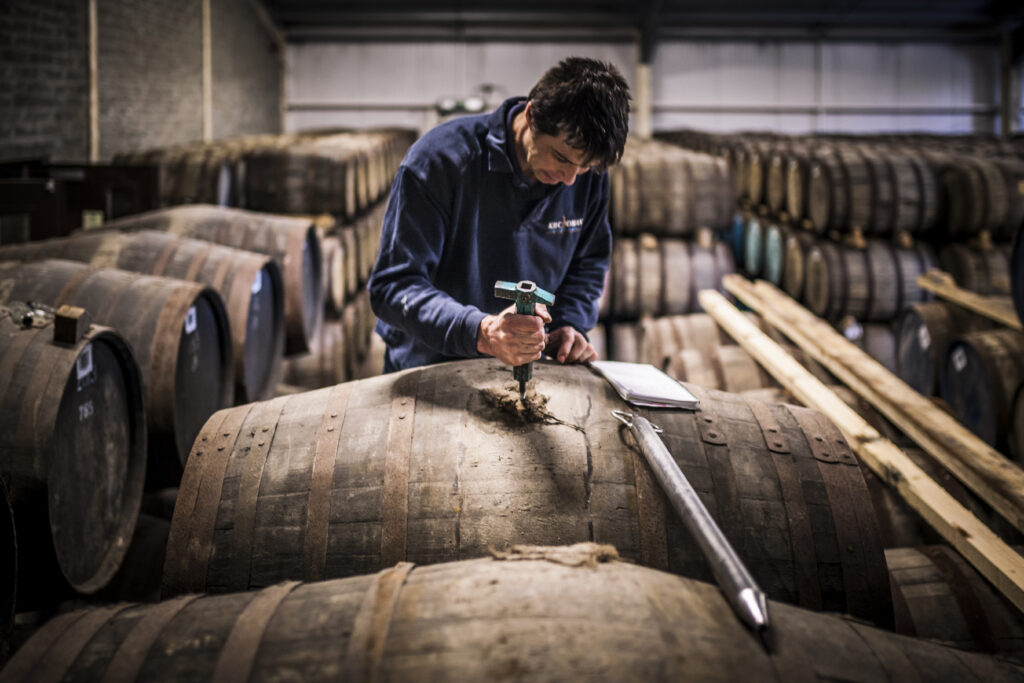
If we were to use lower quality casks or tired oak, we would expect to need to mature for a longer period for the cask to have a noticeable impact on our spirit’s flavour. Sourcing high quality oak, often direct from the previous distillery or bodega allows for a shorter maturation period with more influence.
Each year at Kilchoman we will release a variety of limited-edition bottlings. You may have tasted our PX Sherry, STR or Port cask matured releases. While we openly discuss the maturation and age on our packaging, again, these single malts aren’t driven by an age statement. We mention the year that the whisky was released.
Ultimately, it all comes down to the quality of the single malt in the bottle – whether that happens to be an age-statement or a non-age-statement – the taste should speak for itself.
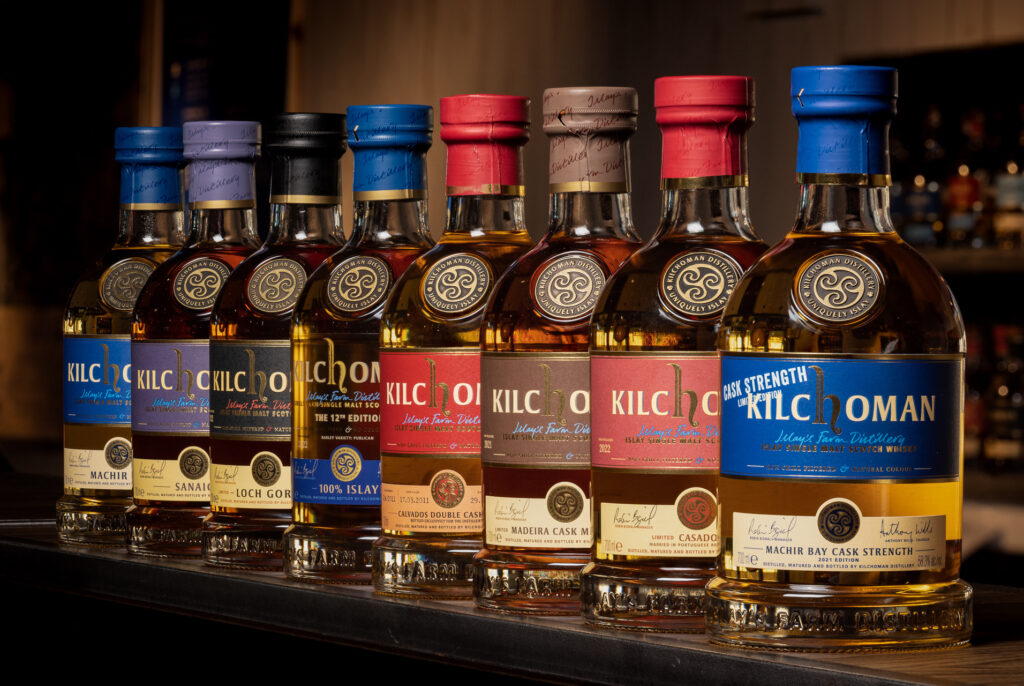
Stay in the know and be amongst the first to hear about new limited releases –
Click here to sign up and join the Kilchoman Club
The Eleventh Edition Club Release is a vatting of three ex-bourbon barrels that have been finished in fresh Sicilian marsala casks for fifteen months before bottling at cask strength, 53% abv. As always, this release is exclusively available to Club Members only.
This year’s Club Release will be available on Wednesday 14th December at 12 noon (Islay time). Bottles are priced at £89.94, 70cl, 53% abv, one bottle per member.
Not a member? Click here to learn more about our Club and sign up.
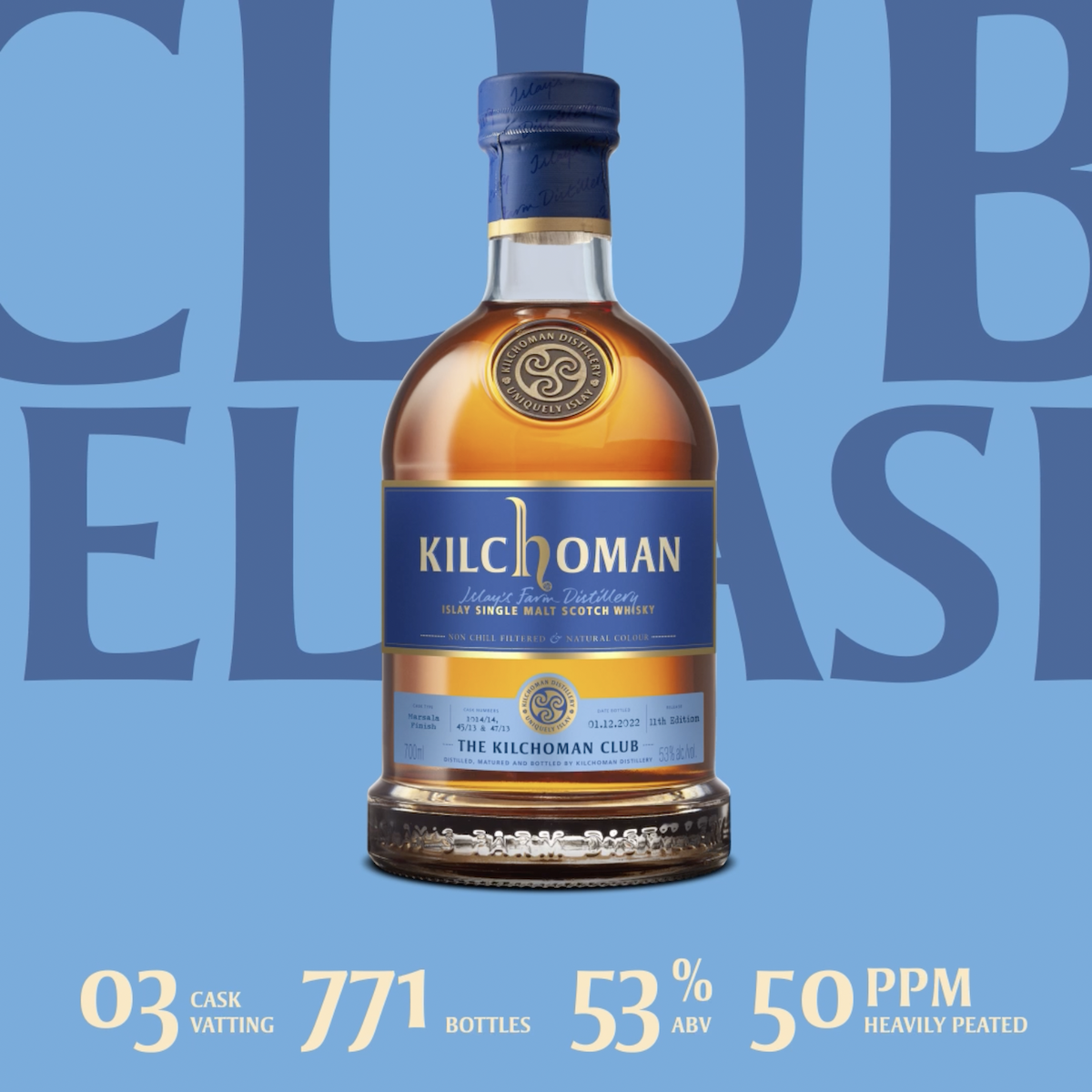
WHERE WE SHIP TO
The Kilchoman Club releases have been launched annually since the first bottling in 2011. These releases are a highlight of the year, created from our rarest casks and experimental spirit runs.
Many of the previous Club releases have celebrated the classic Kilchoman character, a combination oloroso sherry and bourbon cask influence, however this year Anthony and Robin have chosen one of our experimental cask types for the first time since the 2015 club release.
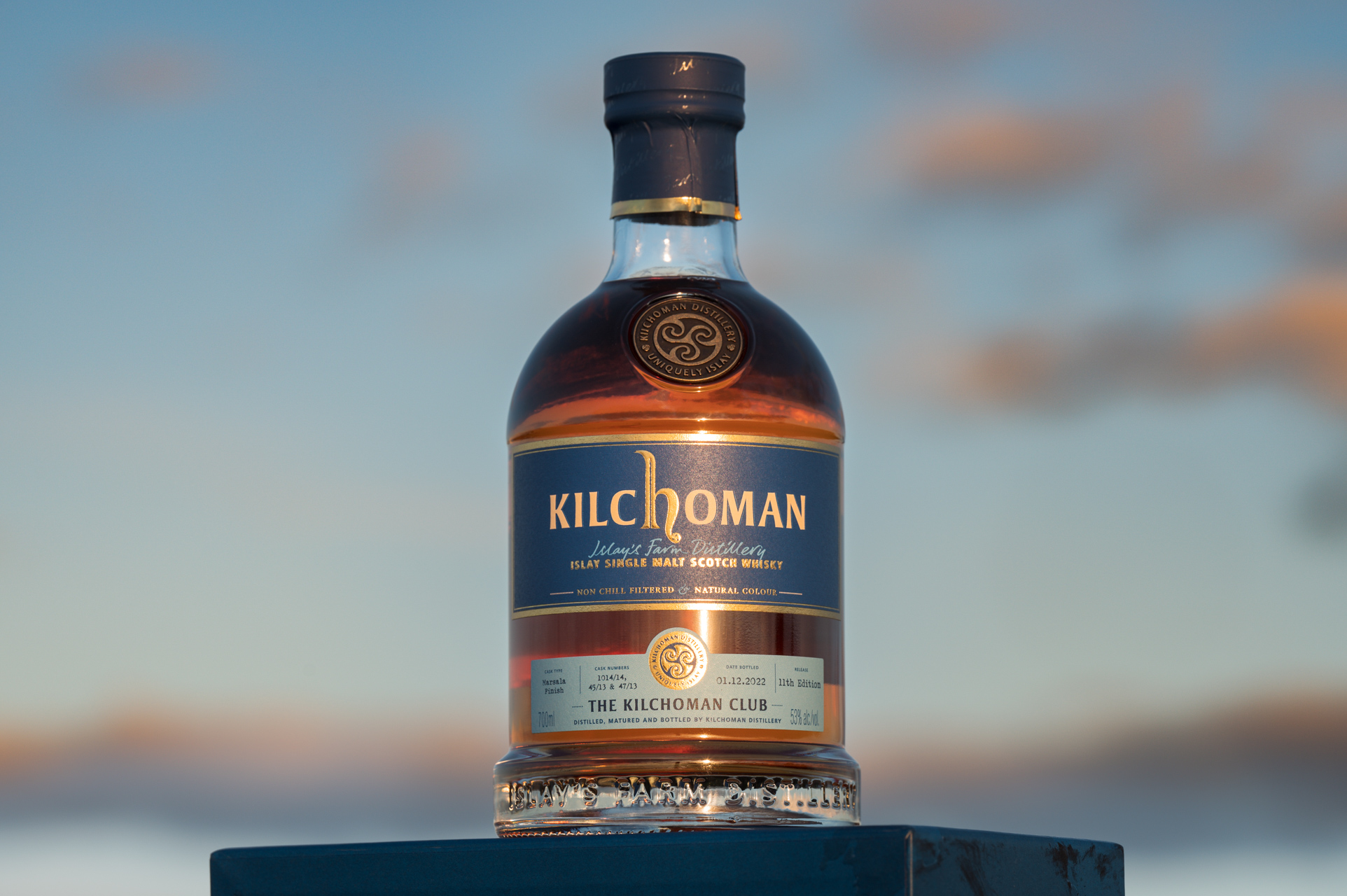
Marsala is a fortified wine produced on the island of Sicily, Italy. The use of only indigenous Sicilian grapes and a complex wine making process gives marsala a uniquely rich character.
“Both sweet wines, like sauternes and fortified wines like sherry, port or marsala, work really well with the peat smoke and citrus character of Kilchoman. The fifteen months finishing in marsala casks has given the whisky notes of golden raisins, toasted almonds and dates, as well as amplifying the vanilla influence coming from the bourbon barrel maturation. On the palate there are waves of juicy fruits with the typical Kilchoman freshness and citrus sweetness.”
“The Club release is also launched on a special day for Kilchoman, our 17th birthday! What a journey it has been to get here and I want to thank you all for your support over the years. Hopefully you will join us in toasting a dram on our birthday. Happy Christmas from all the team here at Kilchoman,” Anthony Wills, Kilchoman Founder and Managing Director.
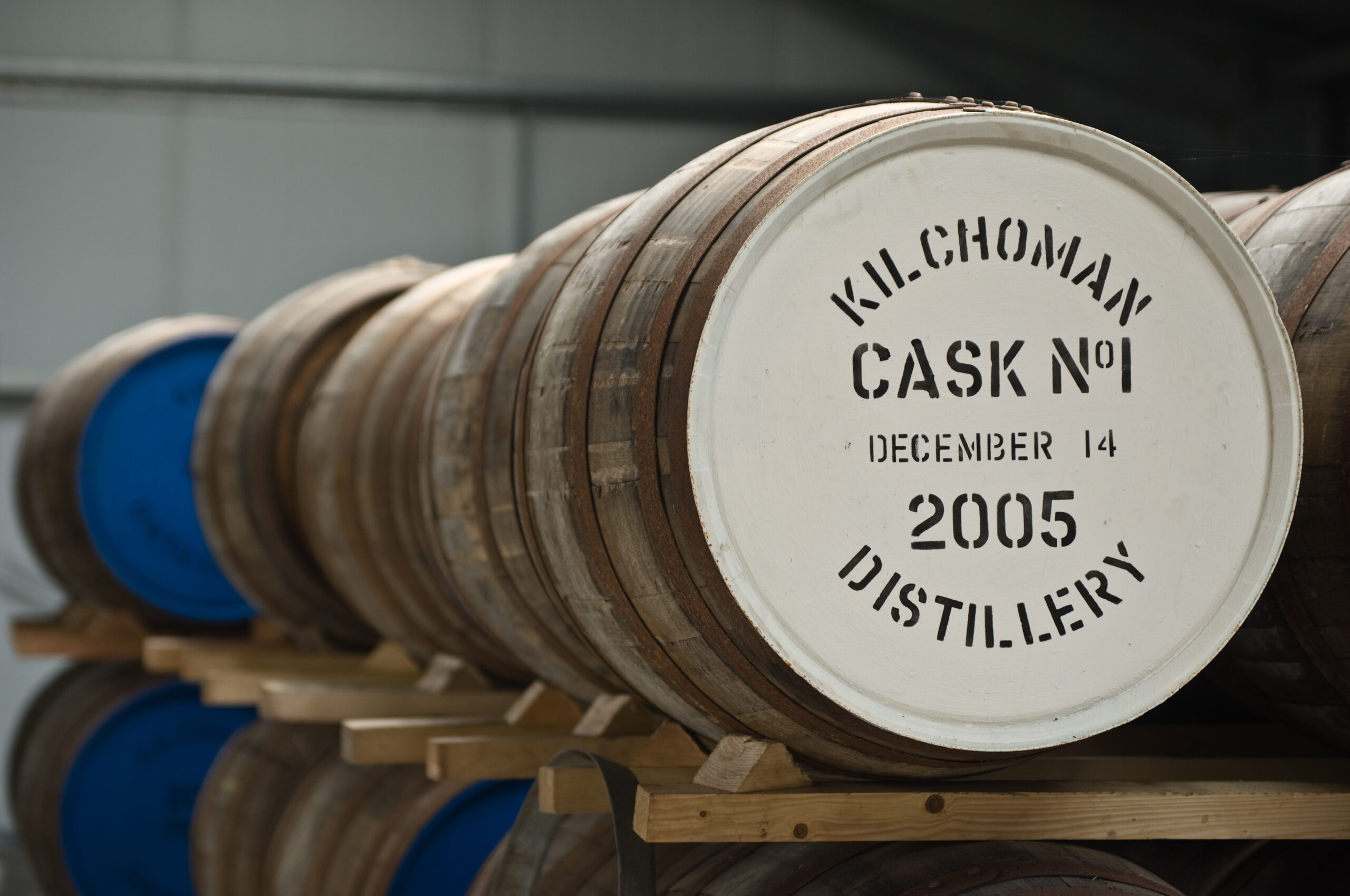
Back by popular demand, the Machir Bay Cask Strength is set for it’s latest edition! With new look packaging, the cask strength release will be hitting shelves just in time for the cold winter nights.
Delayed from its scheduled release last year, the 2021 Machir Bay Cask Strength is finally here (in 2022). This limited edition is made using the same vatting recipe as our regular Machir Bay bottling however rather than reducing the strength to 46% abv we have released a limited number of bottles at cask strength; 58.3% abv. The higher abv allows for the quality and intensity of the Kilchoman spirit to shine.

“Machir Bay at cask strength has such intense flavours, the tropical fruit on the nose jumps out of the glass and the citrus sweetness on the palate is so concentrated and powerful. Cask strength whiskies are such a pure representation of a distillery and maturation, they are hard to beat.”
Anthony Wills, Kilchoman Founder.
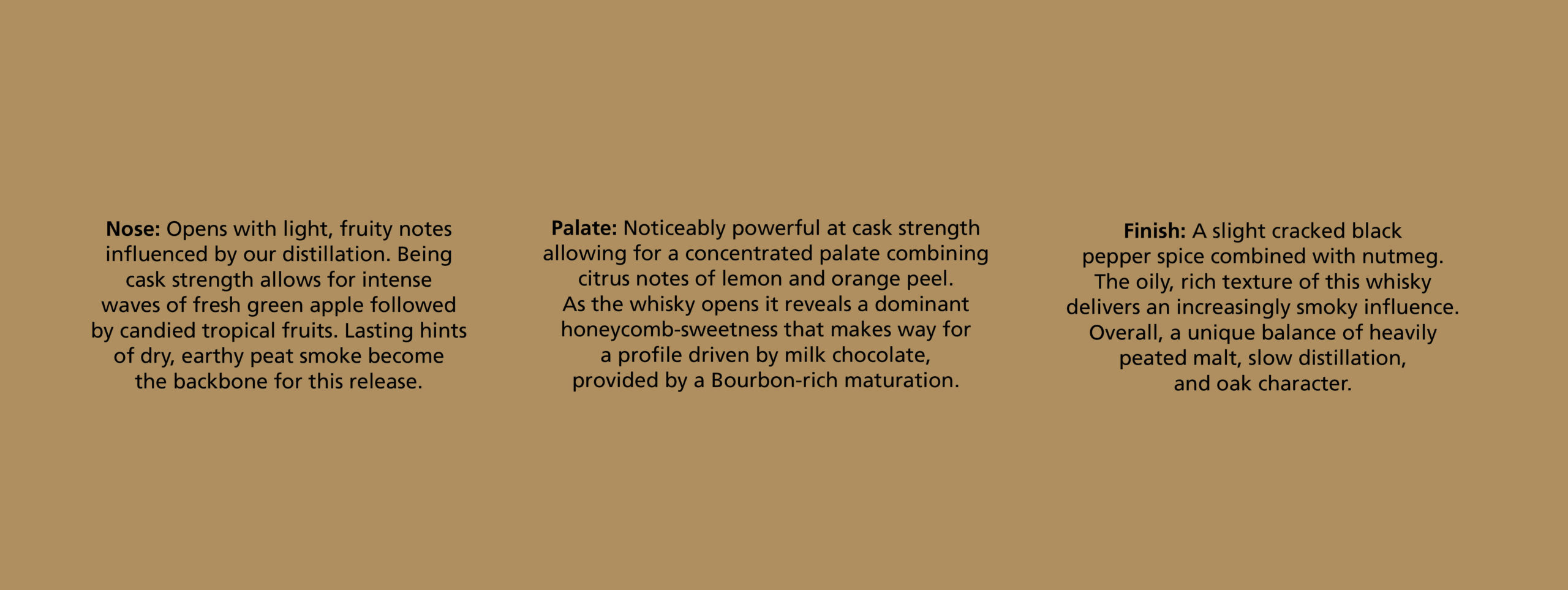
Machir Bay Cask Strength will be available from your regular Kilchoman stockists around the world from this week.
For more information email info@kilchomandistillery.com
Click here to become a Kilchoman Club Member and be one of the first to hear about all our future releases and other news from the distillery.
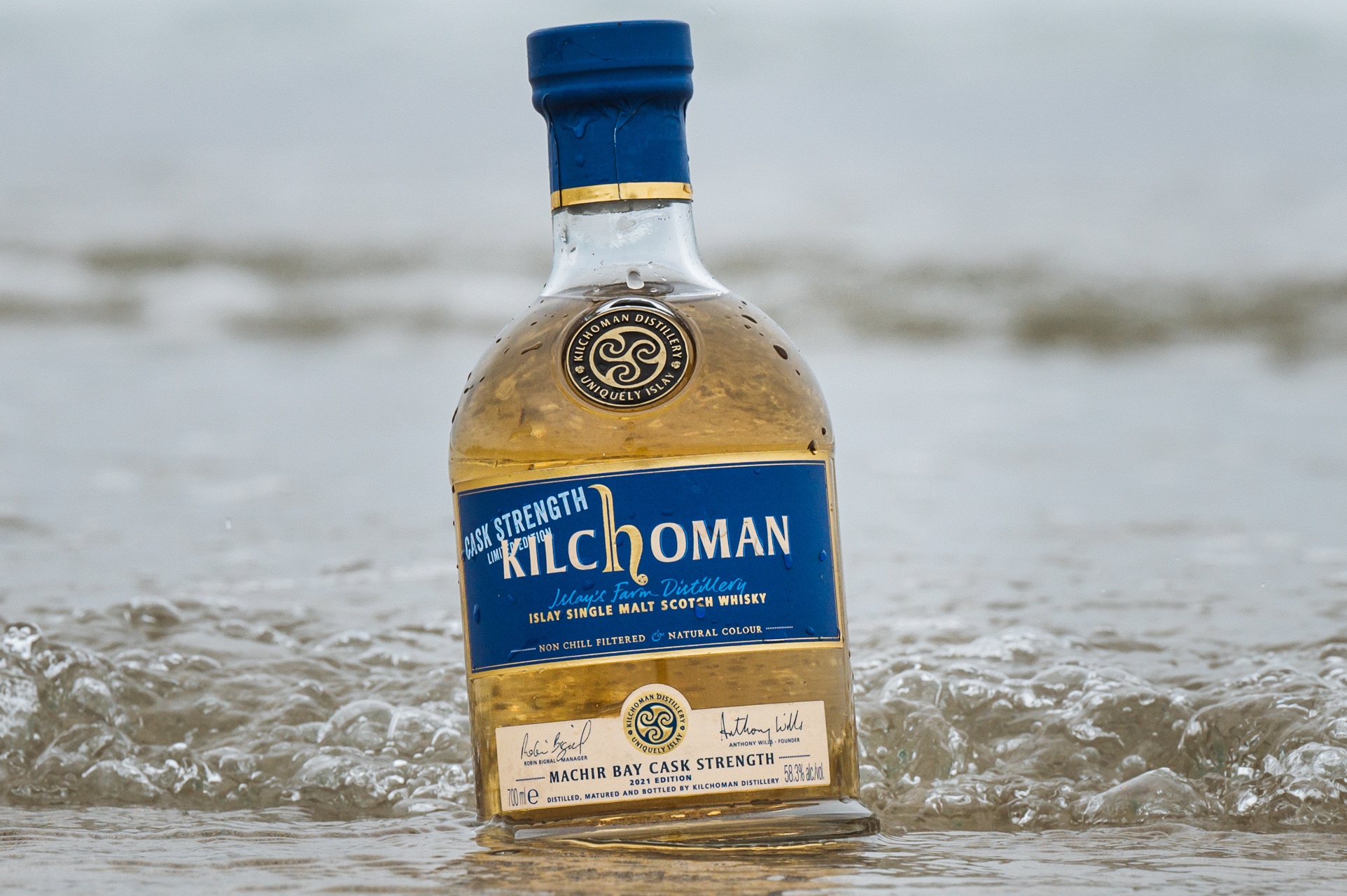
What are the differences between Scotch, Bourbon and Rye?
The most obvious difference between these different styles of whisk(e)y is the spelling, with Bourbon and Rye using whiskey with an ‘e’ whilst Scotch whisky does not use an ‘e’. Aside from the spelling there are a multitude of differences between these iconic spirits; everything from ingredients to production processes and aging.
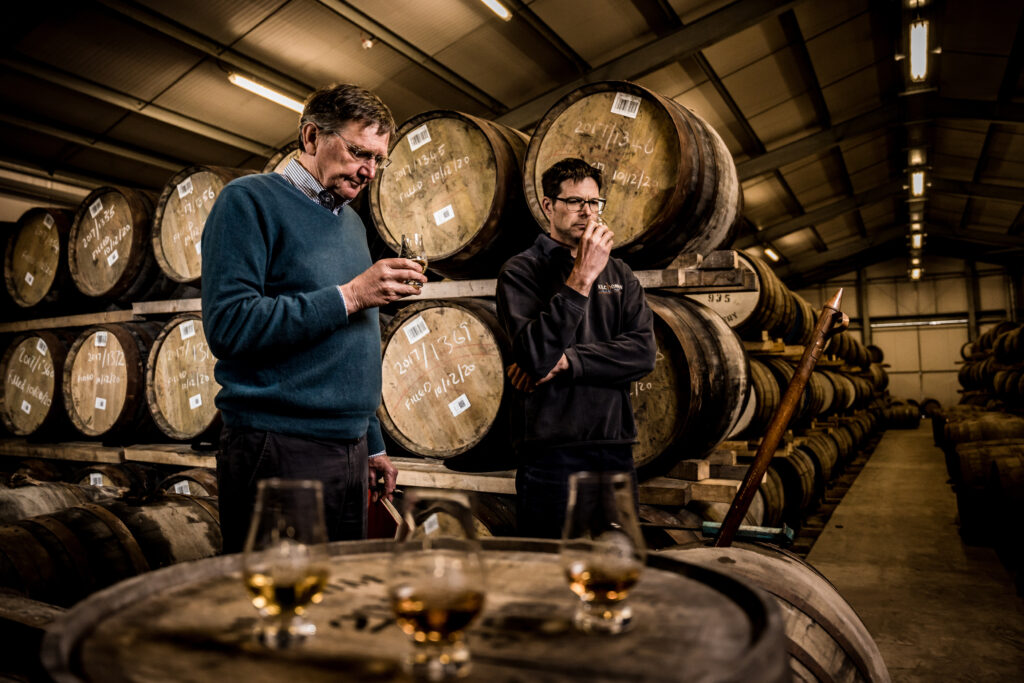
Let’s start with Scotch. Scotch is whisky made in Scotland. All Scotch whiskies need to follow a strict process of production which requires grain, or malt, or both, to be mashed and fermented at the distillery by the simple pitching of yeasts, to then be distilled no higher than 94.8 percent ABV to retain the flavours and aromas of the primary ingredients.
The aging/maturation of Scotch whisky must be done in Scotland, in oak barrels not exceeding 700 litres, for a minimum of 3 years and one day. And must be bottled at a strength no lower than 40% abv.
There are four distinct subcategories of Scotch whisky; Single Malt, Blended Malt, Single Grain and Blended.
- Single Malt whisky must be distilled in batches at one distillery, from malted barley.
- Blended malt whisky is a combination of two or more single malts whiskies.
- Single Grain whisky is distilled at a single distillery however it is typically made from unmalted cereals (usually winter wheat and maize).
- Blended whisky is a combination of whisky made at both single malt and single grain distilleries.
Bourbon is an American distillate. Whilst scotch can be made with a variety of grains, Bourbon must be made with a minimum of 51% corn, which makes it sweeter than most scotches.
Other grains like barley, wheat, and rye make up the rest of the ‘mash bill’ (the mix of fermented grains that are distilled into whiskey). These cereals have different influences on the final character of the spirit, for example an increased proportion of Rye in the mash bill provides a spicy note, while wheat and corn provide a softer, sweeter note.
As the name suggests, Rye whisky is predominantly made from Rye, a grain related to both wheat and barley. Contrary to Bourbon, which is deeply rooted in southern American states, Rye whisky has originated in the northern states and Canada. Though regulations require a minimum 51% Rye in the mash bill, ratios of rye to corn can be as high as 9:1. The use of Rye give the whiskey a distinctly spicy and peppery profile compared to Bourbon.
Distillation
The distillation of most Bourbon, Rye and Blended Scotch whisk(e)y are similar, typically using column distillation to create a light spirit in a cost-effective manner. Single Malt scotch whisky however is batch-distilled in copper pot stills, typically twice, allowing the distiller to collect a broader range of flavours and aromas.

Aging
With any whisk(e)y, Scotch, Bourbon or Rye, much of the flavour is derived from the aging process, when the liquid extracts flavour from oak casks over years or even decades of maturation.
While there are some exceptions, the majority of Bourbon and Rye whiskies are matured in new, charred oak barrels. For this reason, both Bourbon and Rye whiskies tend to be sweeter than Scotch, with caramel, vanilla, maple, roasted coffee and dark chocolate flavours dominant.
Scotch whisky regulations are more flexible in this aspect. Whilst ex-bourbon and ex-rye barrels; used once by Bourbon and Rye distillers then sold to Scotch producers, are the most prevalent type of barrel used for the maturation of Scotch whisky, Scotch distillers can choose from almost any barrel previously used to mature wine of spirit.
This ability to employ an innumerable number of different cask types; sherry, cognac, wine, rum, port, to name just a few, Scotch distillers are able to impart a broader spectrum of flavours into their whisky as it matures. This is evident when comparing Kilchoman releases such as Machir Bay, predominantly ex-bourbon cask matured, with sherry matured Loch Gorm or our Madeira Cask Matured release earlier this year.
Minimum ageing periods also differ each side of the Atlantic, Bourbon and Rye must be matured for a minimum of 2 years whilst Scotch needs to be aged for a minimum of 3 years. Many whiskies are matured for 10, 20 or even 50 years.

The general feeling looking back on the 2022 barley crop, is one of success in the face of typically unpredictable Islay weather.
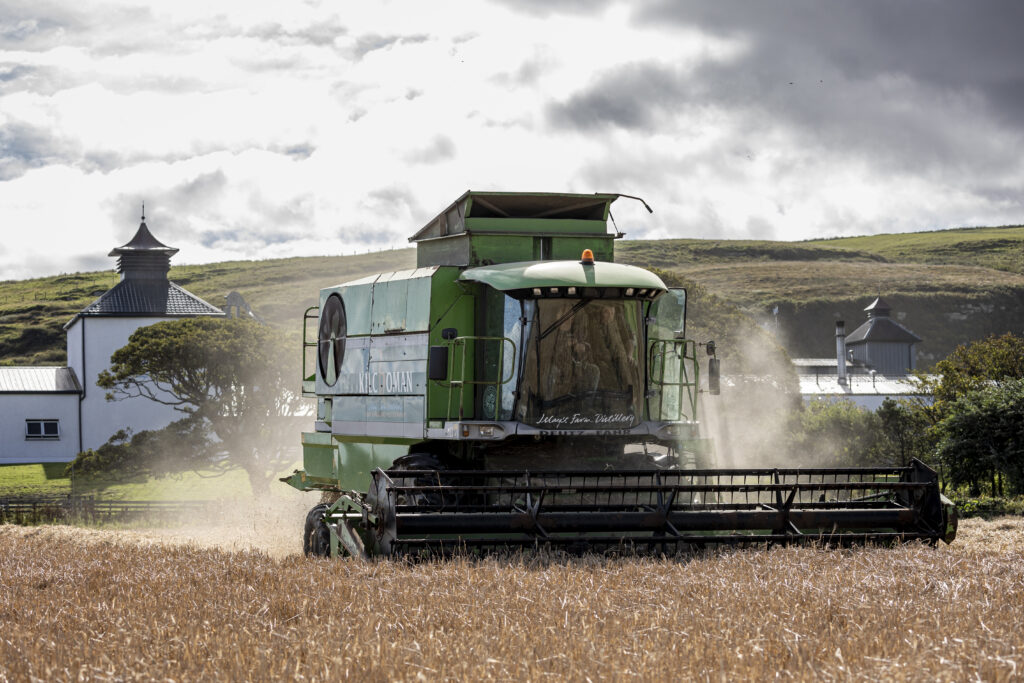
We ploughed and sowed 138 acres of barley by the 26th of April. The soil was cooler than we would have liked but the ground was good and dry, giving the barley a decent seed bed, essential for plant establishment and germination.
The weather on Islay, as many of you will know, doesn’t always do as you would hope, and after we had sown the barley we had a period of rain. Despite this the barley germinated well.
There was plenty of news coverage this year of drought and record temperatures in England… you won’t be surprised to hear that we managed to miss the good weather the mainland was having!
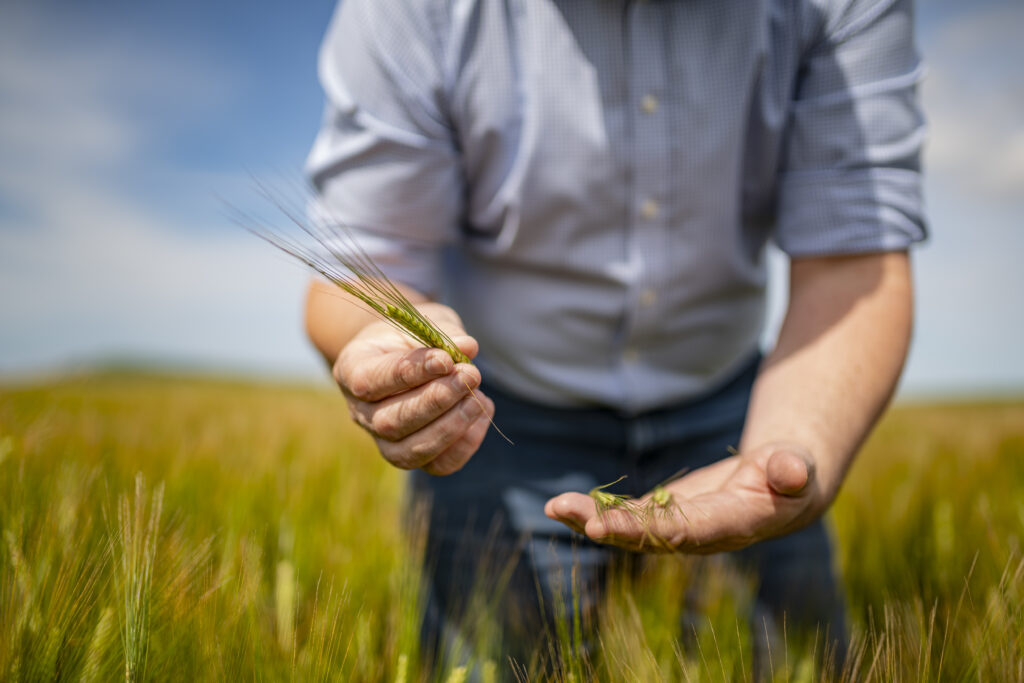
Despite the sun not providing quite as much heat as we’d like, the barley ripened nicely, and we got the first fields combined on the 31st August, harvesting approximately 40 acres. The barley was in good order at this point, presented to the combine; standing upright, allowing the combine to progress easily through the field. Moisture levels were excellent at 17%…
…then came the rain… two weeks of it.
The bad weather did do some damage, in some areas grains had come away from the plant and patches of the crop were lying down flat (due to deer*, wind and rain) BUT, thankfully, most of the barley was still in good condition. Despite what Islay Heads described as a ‘tangled mess” in some particularly exposed areas, we finished harvesting on 17th September.
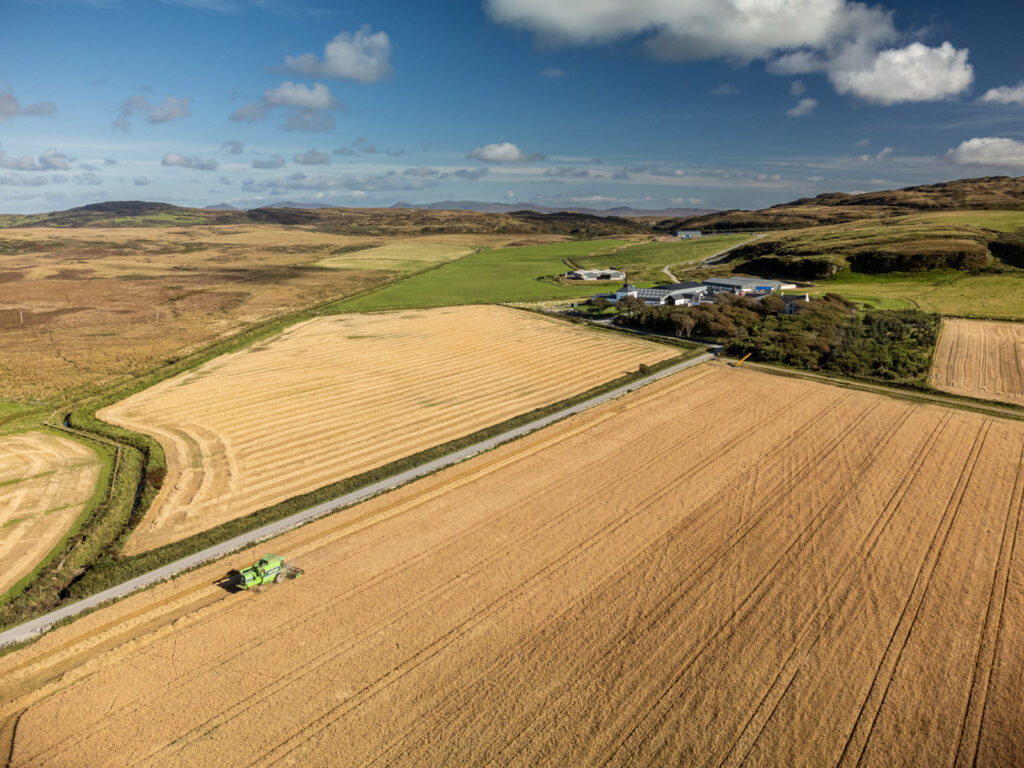
The varieties grown this year were Planet, Sassy and Laurette. Planet and Sassy did well considering the challenges, with Planet showing the best performance. We had a better yield from Planet with the straw holding up against the Islay weather and went through the combine harvester well. Overall, Planet showed less signs of stress compared to Sassy in what was a difficult year for barley on Islay. Unfortunately, the Laurette in the Stone Cottage field never got as far as the combine due to the deer*.
*Red deer come off the hill behind the distillery and eat the barley as it ripens. The stillhouse team would regularly see 20-30 deer in the Smiddy Field, each eating and flattening barley as they move around.
Despite the weather and the deer, we are pleased with this year’s crop. Growing barley on Islay is never going to be easy, otherwise everyone would be doing it, but for us the challenges are worth the reward. We now have 230 tons of Kilchoman barley stored in silos awaiting their moment to journey through the whisky-making process and become our unique Single Farm Single Malt – 100% Islay, from Barley to Bottle.
